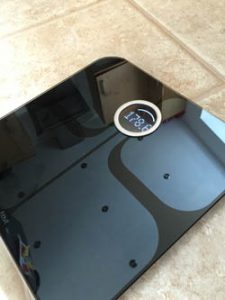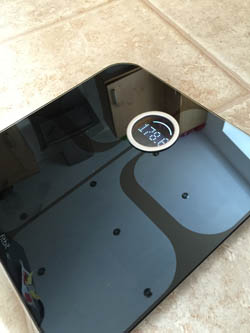FitBit Aria WiFI Smart Scale

Review by Simon Wheatcroft

As the New Year begins and the inevitable diet starts, it’s time to find some accessible weighing scales. I am a fan of consumer-level products over those specifically designed for the visually impaired. I feel there is a lot to be said for a consumer device that is accessible over a device specifically targeted to be accessible.
So rather than purchasing a pair of talking scales, I hunted around for some scales which may be accessible. This led me to the FitBit Aria WiFI Smart Scale. They had two features specifically which drew me in: a very high-contrast screen and a smartphone app. While I am unable to see the screen myself, someone with functional vision may be able to see the high-contrast screen. This out-of-the-box accessibility is refreshing for a product which is not necessarily aimed at the accessible market.
The scales themselves are rather bare, just a black slab with a circular screen. This lack of buttons is an interesting constraint. As there are no buttons the scales are configured through a web browser – for me this meant the web browser on my phone. By visiting the link https://www.fitbit.com/uk/setup/aria you are led through the required steps to configure your scale. Note that there may be a need to place your scales in “Setup Mode,” which is accomplished by simply removing one of the batteries then re-inserting it 10 seconds later.
After the scales are configured and you have entered the relevant details, you are ready to go. Standing on the scales, they are able to identify who you are, which is very handy if you add multiple individuals to your scales, as there is no need to press buttons to select the correct person. Your weight and body fat percentage are displayed on screen, followed by a tick. The information is then synced to the FitBit application and accessible via the FitBit application on your phone or web browser.
As mentioned earlier I am unable to see the screen, so in my case I simply stand on the scales for a count of 15 then step off. I have found this is plenty of time for the scales to identify who you are, weigh you, calculate your body fat percentage, and sync with FitBit.
The FitBit application on the iPhone is very accessible, and if you have an iPhone 5S or later it can also be used to track your steps and calories burned.
Your latest weighing session is shown on the home screen, and tapping through takes you to a detailed breakdown. This is where, for myself, I feel FitBit could have some great improvement. The historic data is plotted on a graph, which is useful if you are able to see the screen. If you are unable to see this graph the only way on the application to access historic data is through a number of sub-menus in a very clunky fashion.
Heading to “Account,” then “Aria,” then “Recent Weigh-ins” gives you a complete tabulated breakdown of the historic weigh-ins. However, as the Aria scale supports multiple users, other users’ information is shown here too, and so accessing your own individual historic information can be a drawn-out process.
A solution to this problem would be for the information within the main weigh-in section to be in the form of both a graph and a table. It would certainly reduce the large amount of gestures required to access historical information.
Overall though, the Aria scales are a highly accessible product. The issue with historic weights is something FitBit could easily address in a future software update, and something I will request they do. Therefore, if you are after an accessible set of weigh-in scales you should really take a look at the fantastic FitBit Aria WiFi Scale.
